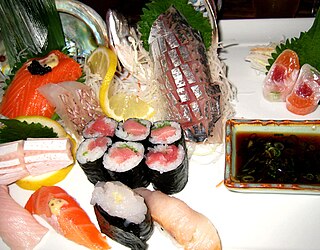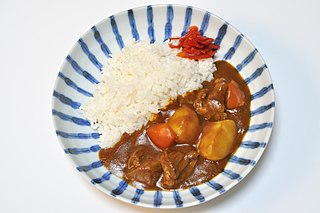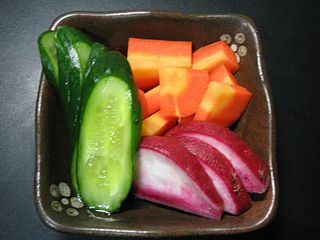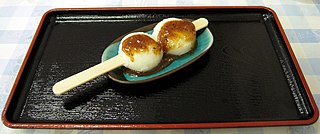
Sushi is a traditional Japanese dish of prepared vinegared rice, usually with some sugar and salt, accompanied by a variety of ingredients, such as seafood, often raw, and vegetables. Styles of sushi and its presentation vary widely, but the one key ingredient is "sushi rice", also referred to as shari (しゃり), or sumeshi (酢飯).

Sake, also spelled saké, is an alcoholic beverage made by fermenting rice that has been polished to remove the bran. Despite the name Japanese rice wine, sake, and indeed any East Asian rice wine, is produced by a brewing process more akin to that of beer, where starch is converted into sugars which ferment into alcohol, whereas in wine, alcohol is produced by fermenting sugar that is naturally present in fruit, typically grapes.

Taiwanese cuisine has several variations. In addition to dishes influenced by the majority Hoklo people, there is much influence from Taiwanese indigenous peoples, Hakka, Waishengren, local derivatives of Japanese cuisine, as well as types of Chinese cuisine from outside Fujian.

Mochi is a Japanese rice cake made of mochigome, a short-grain japonica glutinous rice, and sometimes other ingredients such as water, sugar, and cornstarch. The rice is pounded into paste and molded into the desired shape. In Japan it is traditionally made in a ceremony called mochitsuki. While eaten year-round, mochi is a traditional food for the Japanese New Year, and is commonly sold and eaten during that time.

Edgar Charles "Sam" Rice was an American pitcher and outfielder in Major League Baseball. Although Rice made his debut as a relief pitcher, he is best known as an outfielder. Playing for the Washington Senators from 1915 until 1933, he was regularly among the American League leaders in runs scored, hits, stolen bases and batting average. He led the Senators to three postseasons and a World Series championship in 1924. He batted left-handed but threw right-handed. Rice played his final year, 1934, for the Cleveland Indians. He was elected to the Baseball Hall of Fame in 1963.

Brown rice is a whole grain rice with the inedible outer hull removed. White rice is the same grain without the hull, the bran layer, and the cereal germ. Red rice, gold rice, and black rice are all whole rices with differently pigmented outer layers.

Rice burner is a pejorative term originally applied to Japanese motorcycles and which later expanded to include Japanese cars or any East Asian-made vehicles. Variations include rice rocket, referring most often to Japanese superbikes, rice machine, rice grinder or simply ricer.

Fried rice is a dish of cooked rice that has been stir-fried in a wok or a frying pan and is usually mixed with other ingredients such as eggs, vegetables, seafood, or meat. It is often eaten by itself or as an accompaniment to another dish. Fried rice is a popular component of East Asian, Southeast Asian and certain South Asian cuisines, as well as a staple national dish of Indonesia. As a homemade dish, fried rice is typically made with ingredients left over from other dishes, leading to countless variations. Fried rice first developed during the Sui Dynasty in China and as such all fried rice dishes can trace their origins to Chinese fried rice.

Katsudon is a popular Japanese food, a bowl of rice topped with a deep-fried breaded pork cutlet, egg, vegetables, and condiments.

Omakase is a Japanese phrase, used when ordering food in restaurants, that means 'I'll leave it up to you'.

Japanese curry is commonly served in three main forms: curry rice, curry udon, and curry bread. It is one of the most popular dishes in Japan. The very common "curry rice" is most often referred to simply as "curry".

Methamidophos, trade name "Monitor," is an organophosphate insecticide.

Karaage is a Japanese cooking technique in which various foods—most often chicken, but also other meat and fish—are deep fried in oil. The process involves lightly coating small pieces of the meat or fish with flour, or potato or corn starch, and frying in a light oil. The foods are marinated prior to coating. The process differs from the preparation of tempura, which is not marinated and uses a batter for coating. Karaage is often served alone or with rice and shredded cabbage.

Nukazuke (糠漬け) is a type of Japanese preserved food, made by fermenting vegetables in rice bran (nuka), developed in the 17th century.

Izushi Castle is a yamashiro, or castle situated on a hill, located in Izushi, Hyōgo Prefecture, Japan.

Anne Lucinda Hartley Rice, known professionally as Anneka Rice, is a television presenter, broadcaster, journalist and painter.

Okowa おこわ (強飯) is a Japanese steamed rice dish made with glutinous rice mixed with meat or vegetables. It is sometimes combined with wild herbs and vessel chestnuts. It is generally boiled glutinous rice blended with Azuki beans to give it red color for festive look, made by boiling regular rice with Azuki beans. Since Okowa is meant to be eaten at room temperature, it is used to make onigiri for its capacity to be frozen well.

Japanese dining etiquette is a set of traditional perceptions governing specific expectations which outlines general standards of how one should behave and respond in various dining situations.

Goheimochi is a type of mochi made in the Chubu region of central Japan, specifically in Nagano, Gifu, and Aichi prefectures. Unlike regular mochi it is coated with a type of sweet and sour sauce, usually composed of sugar, soy sauce, and mirin. The mochi is then skewered and grilled. Goheimochi is typically made in one of two shapes: Waraji is shaped like a traditional sandal and rounded mochi is served on a skewer. The mochi is usually only half-cooked so that some grains of rice remain, the rice is usually short-grain rice giving goheimochi a firmer texture compared to standard mochi.



















